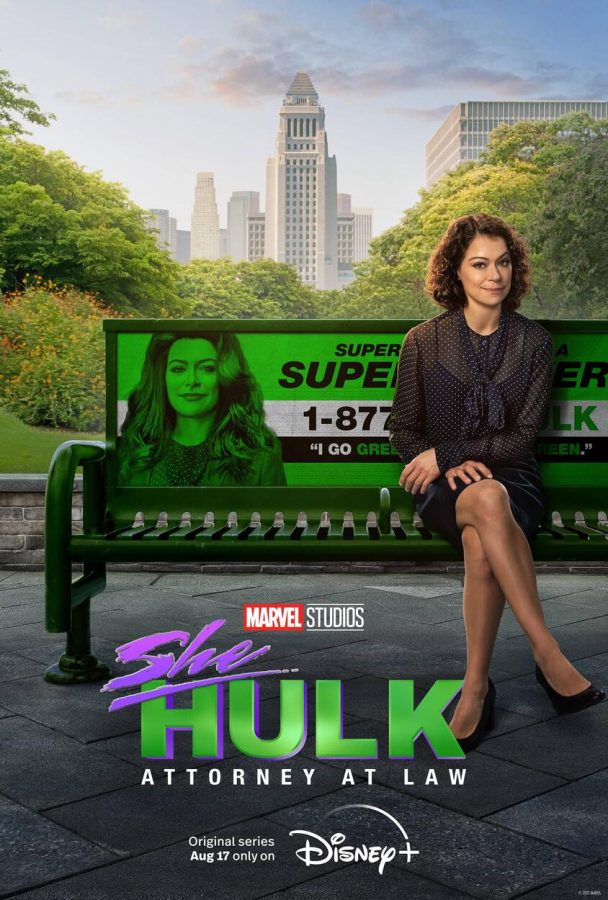“She-Hulk”: Not as smashing as we’d hoped
Disney+’s “She-Hulk” follows Jennifer Walters, an average lawyer from LA seeking to live a normal life. However, these desires are smashed after a car accident causes Jennifer to contract blood from her cousin, Bruce Banner, who also happens to be the Hulk. This blood turns Jennifer into a large, green being just like her cousin. Now, Jenn must balance life as a lawyer with the constant pressure and danger that comes with having superpowers.
And I didn’t really like it.
As a show, “She-Hulk” suffers from what I like to call “post-Endgame-itis”. In other words, before “Avengers: Endgame”, the MCU had a finale it was leading up to, and that meant that every movie within the MCU had a distinct purpose. The plot and quality of every movie had to be held accountable for that larger picture. Now that “Endgame” has come and gone, the MCU’s main story line feels much more like an ethereal enigma, and “She-Hulk” has certainly fallen victim to this new frontier.
“She-Hulk” relies too heavily on MCU conventions and superhero trends rather than relying on complex character development and strong plot. One way this is true within the show is the seemingly random appearances of MCU actors reprising their roles from previous MCU pieces. These roles include Mark Ruffalo as Bruce Banner, Tim Roth as Abomination (from the 2008 Hulk film), Benedict Wong as Wong, and Charlie Cox as Daredevil.
While it is incredibly fun to see these actors back on screen, the writers seemed to think that their combined star power would keep fans satisfied rather than intentionally developing one or two returning characters. What instead resulted was many individual story lines for each of these characters that each followed separate story lines. This–on top of all the new characters and their own stories–makes “She-Hulk” hard to follow.
Speaking of characters, “She-Hulk” suffers from tropey character designs which make the show feel bland and shallow. Characters fit very easily cut molds such as “The Flamboyant Fashion Designer”, “The Super Serious Lawyer”, “The Spiritual Guru”, and “The Douchey Guy Who Only Wants Sex”. These designs don’t inherently create bad characters, but when they are not expanded to anything more than their tropes, they become two dimensional. Many of the characters in this show felt this way, which meant that many moments that were intended to be funny or quirky ended up being more annoying than entertaining.
Unfortunately, our protagonist falls into this category as well. Jennifer Walters fits the mold of “The Fourth-Wall-Breaking Character”.
Fourth wall breaking has become incredibly popular in films, especially superhero films like “Deadpool”. However, when “She-Hulk” breaks the fourth wall, it feels like when your aunt tries to sound trendy by using comic book lingo. Rather than relying on proper character development, “She-Hulk” uses fourth wall-breaking as development. If you took away fourth wall breaking from “Deadpool”, the character would lose something for sure, but you would still have a funny, raunchy character. Take away “She-Hulk’s” fourth wall breaking, and you’re left with a two-dimensional, uninteresting lawyer. For this reason, I did not really like Jenn’s character, which minimized my care for whatever was happening in her life.
Furthermore, the struggles between She-Hulk and the villains of the show feel so utterly vain and pointless. Without spoiling too much, the main villain She-Hulk faces is a young man who thinks She-Hulk doesn’t deserve her powers and that her powers should be given to someone more deserving–which he believes is himself.
This conflict alone has great potential to become an honest point of tension for these characters, but rather than developing this tension, the villain’s reasoning is just chalked up to poorly written misogyny rather than any complex dilemma. The villain is too weak and bland for me to care about his actions.
Another institution that does not work well with “She-Hulk” is the Disney+ MCU television show format. Each Disney+ MCU show has followed a standard pattern that goes like this: Episode 1: Origin, Episodes 2-5: Filler, Episode 6: Big Finale with The New Costume.
Now, filler does not always have to have a negative connotation. Some MCU shows nail this formula like “Hawkeye” and “WandaVision” in which the filler contains exciting bits and pieces that help the finale feel earned rather than just dropped on us viewers.
Not only does “She-Hulk’s” convoluted story make the filler hard to watch, but the first season is also nine episodes instead of the typical six, which drags the story out much too long. The extra three episodes feel like an opportunity wasted.
Even when the filler is over, the finale creates more confusion than clarification. Rather than tying up loose ends, the stories are manipulated to satisfy a ludicrous fourth-wall break. It is odd and unexciting.
SPOILERS
Even though “She-Hulk” leaves much to be desired, there was one episode I really did enjoy. Episode eight reintroduces Charlie Cox’s Daredevil to the MCU after his appearance in “Spider-Man: No Way Home”. Unlike many other weakly written characters, Daredevil brings a breath of fresh air to the show. His motives for his work as a hero are meaningful, and the She-Hulk/Daredevil team-up works great as a pre-finale.
SPOILERS OVER
On a scale from 1-10, I give She-Hulk a 3/10. If you are on the fence about watching the show, I recommend you watch the first episode and the eighth episode, and that’s it. Otherwise, you’ll be left in a whirlwind of confusing, shallow, and bland arcs that leave the audience with several annoyed questions.

Elijah is working his way through his second year at NMSU and his second year at The Round Up as a Lifestyle Writer. He is currently pursuing a major in...

